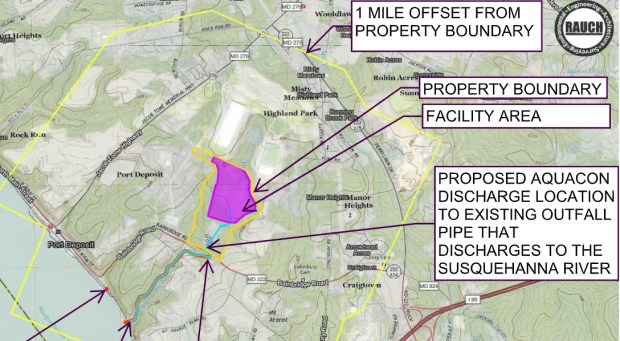A plan to develop Maryland’s first salmon farm, which was shelved last year over environmental concerns about a proposed site on the Eastern Shore, has resurfaced in Cecil County along the Susquehanna River.
This time, the environmental conditions are different, potentially reducing concerns about a harmful effect from the facility and its discharges.
Instead of discharging water into a small stream called Marshyhope that flows into the Nanticoke River, the proposed salmon farm would discharge water through a pipe into the Susquehanna River, the largest tributary of the Chesapeake Bay.
Unlike the Marshyhope River, the Susquehanna River is not a key breeding ground for a threatened species in the bay: the Atlantic sturgeon. Concerns about the sturgeon and the impact that cold water released into the river system by the salmon farm could have on them were the main reasons for the public outcry, which ultimately forced Norwegian company AquaCon to abandon its project.
This time, AquaCon has secured 160 acres for its farm, in the Bainbridge development of Port Deposit, a former naval training center that is being redeveloped for industrial uses. The company plans to build new buildings on the site that would house the salmon throughout their life cycle, from eggs to adult fish, Henrik Tangen, AquaCon’s executive chairman and president, said in a statement to The Baltimore Sun.
Initially, the plant will produce about 10,000 tons of Atlantic salmon per year, Tangen said. Once fully built, the plant is expected to produce double that amount and employ about 300 people, Tangen said.
The county is “thrilled” to potentially host the AquaCon project, County Executive Danielle Hornberger said in a statement.
“This innovative project, which uses clean reservoirs on land and eliminates the need for harmful chemicals, promises sustainable practices that align with our commitment to environmental protection,” Hornberger wrote. “In addition, it will create high-quality manufacturing jobs for our community, promoting both economic development and environmental responsibility.”
AquaCon’s goal is to begin construction in the first half of 2025 and complete its first harvest in the first half of 2028.
In June, the company filed an application for an environmental discharge permit with the Maryland Department of the Environment. Its application is still under review, said Jay Apperson, a spokesman for the agency.
Twice in July, the MDE announced receipt of the request and the possibility of a public meeting on its contents in the Cecil Whig, Apperson said. But no such meeting was requested.
At least one environmental group says the project still deserves further consideration.
The Chesapeake Bay Foundation does not have an official position on the project, but it is reviewing the proposal closely, said Alan Girard, the foundation’s advocacy director.
In particular, the foundation is examining any potential impacts on other species in the Susquehanna River or on key environments that would be downstream of the new facility, such as the vast seagrass bed of Susquehanna Flats.
“We know that this place down the Conowingo [Dam] “There are shad, river herring and other anadromous species that should be present in this area,” Girard said, using the scientific term for fish species that migrate into rivers to spawn. “These species are in low numbers and we need to understand the impacts on their habitat.”
In his statement to the Sun, Tangen said the facility would use raw water from the Susquehanna River, supplied by Artesian Resources Corp., Cecil County’s water and wastewater provider, for salmon in its recirculating aquaculture system, or RAS, and then purify that water before returning it to the river.
“Because we are taking water from the river, the discharge water will be cleaner than the intake water. We are cleaning the intake water to meet the high purity standards needed for salmon production,” Tangen wrote. “The same water cleaning process will be applied to the discharge water, ensuring that all thresholds set for water discharged into the river are met.”
Additionally, the discharge flow would be “tiny” compared to the large flow of the Susquehanna, which is about 0.8 miles wide at the discharge point, Tangen wrote.
The Susquehanna River, which drains much of central Pennsylvania and New York, accounts for about half of the Chesapeake Bay’s fresh water.
“Due diligence of various important criteria, such as access to Susquehanna River water, electrical power, wastewater treatment and logistics (access roads and efficient distribution to customers as well as [the] “The site is right off I-95,” is a very positive thing,” Tangen wrote in his statement.
After a quick analysis, David Secor, a professor at the University of Maryland’s Center for Environmental Science who opposed AquaCon’s former site in Federalsburg, said the company appears to have found “a much better site” where discharges would be significantly diluted.
In his statement, Tangen said the AquaCon team has “more than 60 years of experience planning, building and operating salmon RAS facilities around the world.”
“RAS land-based fish farming is considered the future of environmentally friendly seafood production,” Tangen wrote. “We are very proud to bring this technology to Maryland.”

#abandoning #salmon #farm #East #Coast #company #turns #attention #Cecil #County